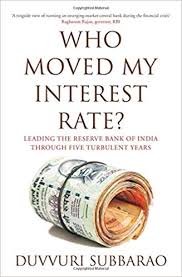I recently read a book by our former Governor of RBI, Duvvuri Subbarao – Who Moved my Interest Rate. The thought behind reading it was to get an understanding of Monetary policy & basics of practical Economics. Subbarao’s major objective of writing the book was to Demystify the Reserve Bank (which also was his thought during his tenure). Below is my interpretation of the book–

- Purpose of Money– Unit of Account, Medium of Exchange, Store of Wealth
- Inflation
-
- Government’s decision to spend on building capital or infra (supply) vs consumption (demand) determines inflation as pool of borrowable money is limited. Private sector mostly borrows to invest in supply side
- Inflation is a regressive tax – the poorer you are, the more you are hit by rising prises (technically we live in a double taxation system – inflation + income tax)
- India – inflation more due to supply side shocks than demand side pressures
- Information
-
- Info asymmetry between central bank and markets is a classic Dilemma – turn avoidable anxiety into panic vs denying ample time to adjust to expected market developments
- Quality of data – everywhere in the world the future is uncertain, in India even the past is uncertain. And so is the case with lot of businesses (Challenge 1 – Get data, Challenge 2 – Get correct data)
- Government
-
- RBI act – the government may give directions to the reserve bank where considered necessary in public interest to do so, but after consultation with the Governor
- General Rule defined by perceptions – Growth vs Inflation = Government vs RBI = Fiscal vs Monetary
- Governments have the short term political cycle that pushes them for expeditions whereas RBI has to remain on long term stability
- Government must set the goal for RBI taking away the goal independence whereas grant full instrument independence to achieve that – true autonomy with responsibility
- Indian Economics
- The governor’s promise – it is the trust that the bearer can exchange that currency note for an equal amount of gold or silver. But this trust ensures that currency notes can be used for transactions without the bearer thinking of exchanging it for precious metal. But this also extends to ensure price stability and keep inflation under check. Thus, unelected technocrats are appointed.
- No gold backed currency now, it is fiat currency printed from a government decree. Now it is a mix of gold bullion, domestic and foreign securities held by RBI
- The amount of forex reserves is a common question any governor faces. If it is believed to be sufficient, people draw inferences that RBI will not intervene in forex market thus, increasing appreciation pressure. If it is insufficient, inferences of volatility and ability of RBI to defend exchange rate thereby pulling it down
- In 1980, amount of forex was about 3 months of import cover. It was coz trade flows dominated balance of payments & determined exchange rates. Today, global capital flows are several multiples of trade flows. Exchange rates are more a function of capital account of BOP rather than current account
- NBFC – their role is important since they plug the gaps left by banks. But they must be controlled as banks transfer their risky assets to these shadow banks, thereby freeing up space for themselves for further lending which leads to unsustainable debt build up and near total implosion of global financial system
- Loan to value ratio (LTV) for NBFC to regulate gold as collateral for loan to prevent Indian version of subprime crisis
- Exchange Rates
-
- When CAD is high, an exchange rate correction is inevitable due to structural imbalances as the money in circulation is limited overall. As imports rise, lower capital remains to invest in increasing investment opportunities, thereby weakening your currency
- Currency wars – a situation when countries competitively depreciate their currencies against those of trading partners in order to cost exports and restrain imports. They are ultimately self-defeating as they depress trade and raise the cost of all trading partners involved. The latest example – advanced economies ultra-easy monetary policy (0 interest rate) topped by quantitative easing to stimulate economy. This huge liquidity found its way into emerging markets for quick returns, which they lacked capacity to absorb, thus their exchange rates appreciated out of line with their economic fundamentals
- Dollar as the sole reserve – why even after US being the epicentre of crisis, the dollar actually appreciated? Dollar investors around the world began withdrawing their investments. Thus pushing up dollar exchange rate. This resulted in dollar shortage outside threatening smooth functioning of global payment systems. Fed also provided bilateral swap arrangements with select countries, whose markets impact US. Euro was pitted as the alternative but the sovereign debt crisis killed that project. Now yuan is the second largest currency in international trade and finance. Funnily, yuan denominated bonds are called dim-sum. Dollar enjoys this privilege also because America is running a consistent trade deficit thereby maintaining enough liquidity of dollar (Triffin paradox)
- Roadblocks to yuan – exchange rate to be freely market determined, yuan should become freely convertible in global capital accounts. Also, yuan misses out on the third objective of money (acting as a store of wealth)
- IMF SDR( special drawing rights) basket consists of dollar, euro, sterling, yen and yuan (added in 2015)
Do share your views/feedback in the comments section
[…] Real money by definition – Medium of exchange, Unit of account, Store of value (read fundamentals of money explained by a former RBI Governor) […]
Like!! Great article post.Really thank you! Really Cool.